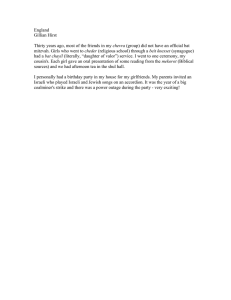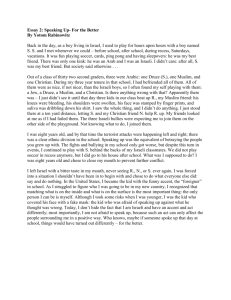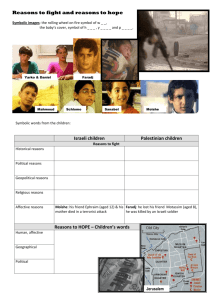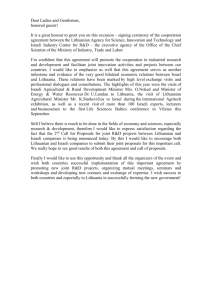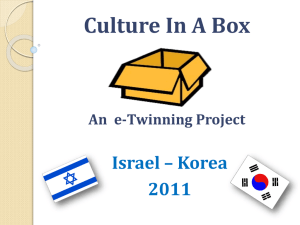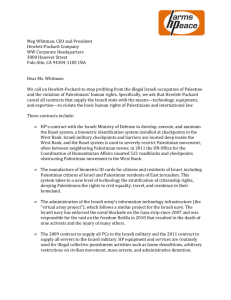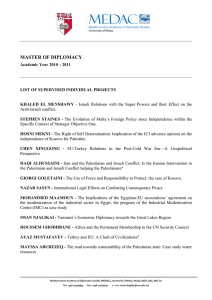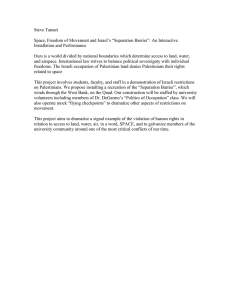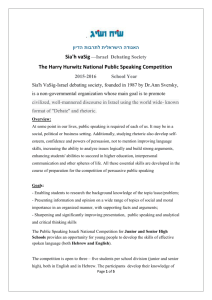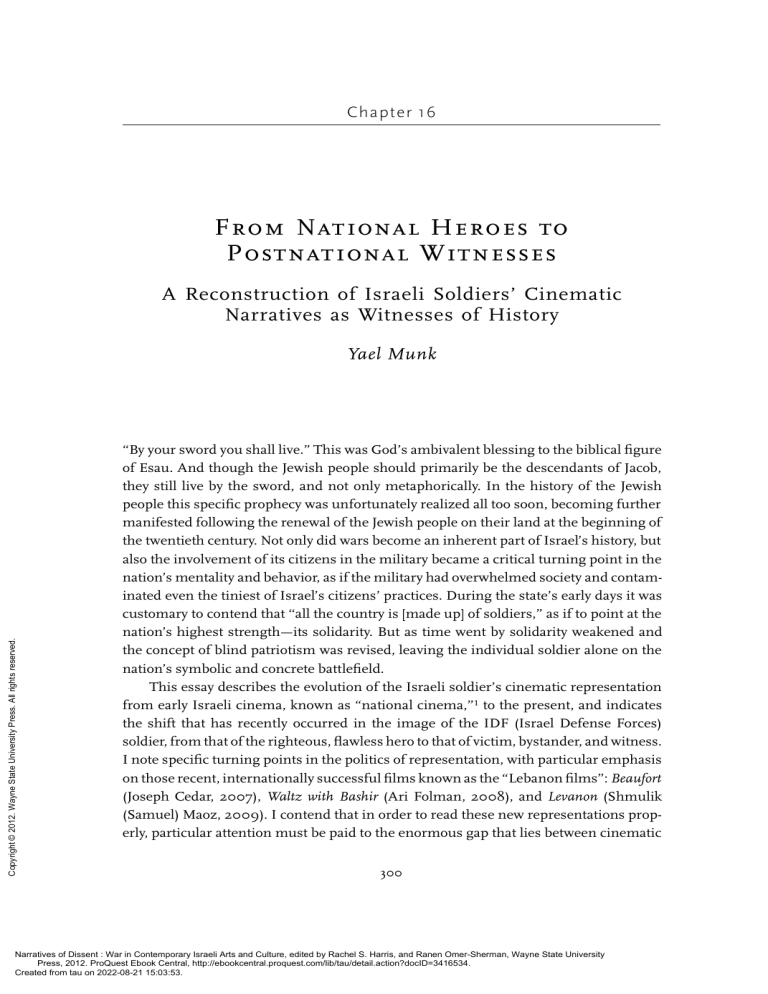
Chapter 16 From National Heroes to Postnational Witnesses A Reconstruction of Israeli Soldiers’ Cinematic Narratives as Witnesses of History Copyright © 2012. Wayne State University Press. All rights reserved. Yael Munk ‘‘By your sword you shall live.’’ This was God’s ambivalent blessing to the biblical figure of Esau. And though the Jewish people should primarily be the descendants of Jacob, they still live by the sword, and not only metaphorically. In the history of the Jewish people this specific prophecy was unfortunately realized all too soon, becoming further manifested following the renewal of the Jewish people on their land at the beginning of the twentieth century. Not only did wars become an inherent part of Israel’s history, but also the involvement of its citizens in the military became a critical turning point in the nation’s mentality and behavior, as if the military had overwhelmed society and contaminated even the tiniest of Israel’s citizens’ practices. During the state’s early days it was customary to contend that ‘‘all the country is [made up] of soldiers,’’ as if to point at the nation’s highest strength—its solidarity. But as time went by solidarity weakened and the concept of blind patriotism was revised, leaving the individual soldier alone on the nation’s symbolic and concrete battlefield. This essay describes the evolution of the Israeli soldier’s cinematic representation from early Israeli cinema, known as ‘‘national cinema,’’∞ to the present, and indicates the shift that has recently occurred in the image of the IDF (Israel Defense Forces) soldier, from that of the righteous, flawless hero to that of victim, bystander, and witness. I note specific turning points in the politics of representation, with particular emphasis on those recent, internationally successful films known as the ‘‘Lebanon films’’: Beaufort (Joseph Cedar, 2007), Waltz with Bashir (Ari Folman, 2008), and Levanon (Shmulik (Samuel) Maoz, 2009). I contend that in order to read these new representations properly, particular attention must be paid to the enormous gap that lies between cinematic 300 Narratives of Dissent : War in Contemporary Israeli Arts and Culture, edited by Rachel S. Harris, and Ranen Omer-Sherman, Wayne State University Press, 2012. ProQuest Ebook Central, http://ebookcentral.proquest.com/lib/tau/detail.action?docID=3416534. Created from tau on 2022-08-21 15:03:53. Israeli Soldiers’ Cinematic Narratives as Witnesses of History military representations from the very first days of the State of Israel, when the image of the soldier served as an extension of the national discourse, to the present day, when images of soldiers not only stand for themselves but also introduce a counternational discourse in which subjectivity rules. Thus the theoretical framework of this essay, although engaging with the war film genre, is more concerned with the fading of nationalism and its substitution by life-saving issues, particularly the soldier-narrator’s life. These recent films challenge the issue of national historiography and raise the ethical issue of the soldier’s responsibility and/or complicity in the ‘‘spectacle’’ of war, an issue that in recent Israeli war films tends to be partly solved through powerful aesthetic choices that seem to question the ‘‘spectacular’’ nature of war. Copyright © 2012. Wayne State University Press. All rights reserved. Soldiers in Early Israeli Cinema Wars have haunted Israeli cinema since its inception. As such they always received a privileged place in the films’ narratives. Throughout the years, the Israeli screen has helped in turning the war into an unquestionable fact of life, so much so that even ‘‘innocent’’ narratives that at first sight deal with everyday life can reveal, on close reading, war’s imminent threat to the protagonists or the e√ect of its consequences on their lives.≤ Israeli cinema invested much e√ort in the reconstruction of a national narrative, supported by those who had sacrificed their lives for the birth of the Jewish state. As Ella Shohat wrote: ‘‘the death of the protagonists [. . .] is allegorically compensated by the rebirth of the country—the ultimate protagonist of the film[s].’’≥ One such example is Thorold Dickinson’s Hill 24 Does Not Answer (Giv’a 24 Eina Ona) (1955), which remains to this day the cinematic epitome of the national myth and of the role of the Israeli soldier in it. In this film a group of four young soldiers of di√erent national origins—one Irish, the second American, the third a native Israeli, and the fourth a Yemenite girl—are assigned to guard ‘‘Hill 24’’ on the eve of the Declaration of Independence. When all four are found dead at their outpost, the film retraces their story in flashbacks, in which we learn about their deep conviction in the need to protect the Jewish state and their willingness to die for it. Their deaths are thus made less tragic because of the great national cause that they had served. In Hill 24 Does Not Answer the four are symbols of the incontestable price to be paid for the state’s independence, and their becoming national heroes is seen as worthy compensation for the loss of their lives. A similar approach can be found in the historical narrative of They Were Ten (Baruch Dinar, 1960), in which a group of ten settlers confronts the hardships of the barren land, a situation that leads to the death of the only female protagonist. Once again the film presents the death as a painful but worthy cause, that of having contributed to the Jewish nation’s settlement on its land. However, a few years later the general atmosphere changed and Israelis began to feel that they no longer had to justify their right to exist on their land, except, of course, in times of war. Two major war films were made in the late 1960s, demonstrating this new Israeli approach. The first one is Yosef Miloh’s 1967 cinematic adaptation of Moshe 301 Narratives of Dissent : War in Contemporary Israeli Arts and Culture, edited by Rachel S. Harris, and Ranen Omer-Sherman, Wayne State University Press, 2012. ProQuest Ebook Central, http://ebookcentral.proquest.com/lib/tau/detail.action?docID=3416534. Created from tau on 2022-08-21 15:03:53. YA E L M U N K Shamir’s canonic novel He Walked in the Fields (Hu Halach BaSadot) (1947). Set on the eve of the War of Independence (1948), the film follows its literary source and tells the story of Uri (symbolically played by Assi Dayan, son of the most famous Israeli general of all time), the first son born to his kibbutz and educated to unconditional patriotism.∂ After falling in love with one of the kibbutz’s newcomers, he suddenly hesitates in the face of his patriotic duty. These hesitations that, according to Nurith Gertz, marked the first break in the national consensus, are solved in the film’s narrative when the protagonist puts an end to his hesitation by sacrificing himself in the service of the nation. In other words, the military is no longer seen only as a contribution to the nation’s existential needs but also as a way to escape conflicted situations. This approach is repeated in Uri Zohar’s Every Bastard a King (Kol Mamzer Melech) (1968), whose plot takes place on the eve of the Six-Day War, as two Israeli friends who accompany an American journalist around the country discover the emptiness of their existence. Only when war is declared do the two finally find their true calling: one of them happily goes to the battlefront, where he meets with his friends and fights for victory; the other flies to Cyprus with the purpose of promoting peace talks with the Arab countries. When the latter comes back with no real achievements, he realizes that the war is already over and he has ‘‘missed’’ it, which means that he did not have the chance to participate in the most glorious event of the country. As opposed to the early nationalist films, these two latter narratives present the participation in war as a choice that needs to be made if one wants to give meaning to one’s life. Copyright © 2012. Wayne State University Press. All rights reserved. A Dramatic Turnover: Witnesses and Bystanders in Paratroopers and Khirbet Khizeh With the emergence of the New Sensibility cinema in the late 1960s, the ‘‘national cinema’’ genre faded and the question of heroism became irrelevant.∑ When it reappeared on the Israeli screen, it was after the trauma of the Yom Kippur War and the right-wing government’s first rise to power in 1977. The general feeling of the 1948 Generation was one of failure, not only failure to perpetuate the values inherited from the founding fathers but mostly failure to react to the Six-Day War and its political consequences. Suddenly Israeli cinema turned back to politics, and more particularly to the IDF as one of the main sites where the Israeli politics of occupation is pursued. War was no longer accepted as a fait accompli, and war-associated issues became a predominant theme, but this time the cinematic point of view was overtly antiheroic. The war films produced from the late 1970s and during the 1980s spoke in a provocative, postnational way, deconstructing the dichotomy between us and them, between the nation and the enemy, and replacing it with a transnational humanistic approach.∏ Two major films focusing on soldiers and their role in supporting the military system were released in the late 1970s, introducing this new era of war films in Israeli cinema: Judd Ne’eman’s Paratroopers (Masa Alunkot) (1977) and Ram Loevy’s Khirbet Khizeh (1978). Although both films were conceived long before the political upheaval, 302 Narratives of Dissent : War in Contemporary Israeli Arts and Culture, edited by Rachel S. Harris, and Ranen Omer-Sherman, Wayne State University Press, 2012. ProQuest Ebook Central, http://ebookcentral.proquest.com/lib/tau/detail.action?docID=3416534. Created from tau on 2022-08-21 15:03:53. Copyright © 2012. Wayne State University Press. All rights reserved. Israeli Soldiers’ Cinematic Narratives as Witnesses of History their release at this historical moment revealed their creators’ sense of guilt vis-à-vis the new political situation that they had failed to prevent. Ne’eman’s Paratroopers was the first film to deal with the way in which the IDF molds its soldiers. Tracing a parallelism between military training and blind ideological indoctrination, the formalistic plot’s first part follows the attempts of Weizman (Moni Moshonov), an unfit soldier, to integrate into a prestigious paratrooper boot camp, and his failure to do so, ending in his suicide. The second part deals with the way his commander, Yoni, whose brutal acts directly led to Weizman’s suicide, copes with the tragic events or, rather, refuses to assume any responsibility. A similar iconographic framing showing a large group of soldiers singing ‘‘dirty’’ military songs on their way to a training day opens and closes the film text. The viewer, who has followed Weizman’s tragedy and his o≈cer’s inability to assume responsibility, understands that the IDF is no more than a blind machine whose functioning will not stop because of one single soldier’s death. The repetition of the group shot at the end of the film reinforces in the viewer’s mind Weizman’s absence and, by extrapolation, the unspoken inhuman aspects of the military system. Paratroopers was a novel event in Israeli cinema. Not only has military training per se never been at the center of a film narrative but also the depiction of its o≈cers, and particularly of Yoni, revealed the unspoken sadistic sides of the military, whether the IDF or another army. Military training was depicted not as a rigorous process, intended to create the team-building ethos that would eventually turn youth into men, but rather as a system sometimes more brutalizing than combat itself. In an interview with Janet Burstein,π Ne’eman admits that what had motivated his writing of the Paratroopers script was not his experience during the Yom Kippur War (1973) but rather his witnessing during the Six-Day War of the physical and spiritual tortures implied by military pedagogy. Basic training in the military teaches a soldier two things: (1) how to injure and kill the enemy and (2) how to endure being injured and being ready and willing to su√er and die. In basic training soldiers learn much about weapons, tactics, and ways to protect themselves and hurt the enemy. But the military does not teach the soldiers anything about the other art to which they are initiated: how to get hurt and how to get used to su√ering, and to the idea that they will die soon. All the military tells the soldiers is how to apply dressings to wounds. Contrary to Nitzan Ben-Shaul’s contention, according to which ‘‘Paratroopers is a film based both formally and rhythmically upon American films protesting the Vietnam War [though] unlike theirs, however, its protest is hopeless, and therefore pointless, and is confined to the military establishment without reference to the public sphere,’’∫ Paratroopers was a direct criticism of the military ethos that had been so central to Israeli existence, and though it did not o√er any viable solutionΩ it pointed at a major political issue: the revelation that during basic training young soldiers could be abandoned to the indi√erent and often sadistic whims of their o≈cers. This terrible ideological iconoclasm led to the film’s ambivalent reception in real time, reflecting Israeli society’s inability to cope with the shattering of such a consensus of belief. Only years later was 303 Narratives of Dissent : War in Contemporary Israeli Arts and Culture, edited by Rachel S. Harris, and Ranen Omer-Sherman, Wayne State University Press, 2012. ProQuest Ebook Central, http://ebookcentral.proquest.com/lib/tau/detail.action?docID=3416534. Created from tau on 2022-08-21 15:03:53. YA E L M U N K Copyright © 2012. Wayne State University Press. All rights reserved. Khirbet Khizeh (1978) from filming. Paratroopers recognized as one of the major film texts foreshadowing the paradigmatic political turn in Israeli cinema. Paratroopers was in fact a testimony from inside the IDF. The invisible witness (who is no other than the filmmaker himself ) structured the soldier’s destiny into a dialectic plot in which the thesis (unfit soldier is pushed to suicide) and antithesis (this soldier’s o≈cer is unable to assume responsibility toward the soldier’s family and peers), leads to a synthesis regarding the military’s indi√erence to the individual’s life. Weizman’s tragic story and the absence of response to it reflected the break in the basic trust between the individual soldier and the military system, a theme that, as this article sets out to demonstrate, has become central to recent Israeli war films. The other film that predicted this paradigmatic shift in the Israeli consensus was Ram Loevy’s Khirbet Khizeh (1978), an adaptation of S. Yizhar’s eponymous novel based on his own memories of his part in Israel’s War of Independence and published immediately after it (1949).∞≠ Khirbet Khizeh narrates in first person singular the story of what seems to be a minor event during the 1948 war. Just like many other Israeli soldiers, a small group of young soldiers was ordered to take the Palestinian village of Khirbet Khizeh,∞∞ to blow up its houses and expel all the Palestinian women, children, and elderly men remaining there. Following the novel’s narration, Loevy’s film chooses to keep the voice-over for the description of the events. The narrator is Micha, the handsome fair-haired and blue-eyed sabra (native Israeli). Conforming to the image of the New Jew, Micha is mostly invested in describing the beautiful landscape and at first seems to ignore the moral implications of his deeds. The opening sequence shows the soldiers playing childish games, waiting for orders. When Micha is declared the winner 304 Narratives of Dissent : War in Contemporary Israeli Arts and Culture, edited by Rachel S. Harris, and Ranen Omer-Sherman, Wayne State University Press, 2012. ProQuest Ebook Central, http://ebookcentral.proquest.com/lib/tau/detail.action?docID=3416534. Created from tau on 2022-08-21 15:03:53. Israeli Soldiers’ Cinematic Narratives as Witnesses of History Copyright © 2012. Wayne State University Press. All rights reserved. Khirbet Khizeh (1978) from filming; director Ram Loevy on left. of the competition, the camera freezes his face on the screen in a low-angle shot, in order to create identification between the voice-over and the face of the narrator.∞≤ Micha’s confession progresses, and in spite of his very little involvement in the mission it is carried out and his moral conflict grows. The camera shows him standing aside from the invasion of the village; he silently follows his friends, at most trying to show some human compassion, particularly in the final sequence when he decides to bring water to the evicted Palestinians being loaded onto the truck. But even this purely humanistic act fails to attain its goal, and when he runs back to the truck with the jerry cans of water he finds that it has already departed. Micha’s description should be understood as the confession of the bystander who could not prevent the cruel acts in real time. His stream-of-consciousness narration, interweaving descriptions of the beautiful landscape with his mixed feelings vis-à-vis the mission, forms the basis of the moral conflict of the hero. In his analysis of Yizhar’s novel, Hannan Hever contends that just like in the novels of Israel’s first generation the national war in Khirbet Khizeh obeys the national consensus, according to which the end justifies the means, and the narrator, Micha, understands that the destruction of the village is necessary since the land will serve for the settlement of new Jewish immigrants, those same Jews with whom the new country will be built.∞≥ In these literary oeuvres, Hever contends, the Palestinian’s Otherness remains outside the main narrative and accordingly outside the hero’s hesitations and thoughts. Micha’s stream of consciousness hints at an analogy between the expelled Palestinians and the expelled 305 Narratives of Dissent : War in Contemporary Israeli Arts and Culture, edited by Rachel S. Harris, and Ranen Omer-Sherman, Wayne State University Press, 2012. ProQuest Ebook Central, http://ebookcentral.proquest.com/lib/tau/detail.action?docID=3416534. Created from tau on 2022-08-21 15:03:53. YA E L M U N K Jews of Europe, as both have become refugees as a result of historical circumstances. The parallelism that is drawn between the two populations attenuates the su√ering of the expelled Palestinian villagers as well as the moral dilemmas of the narrator. However, the fact that he reconstructs the ‘‘simple operation’’ he had witnessed and only partly participated in, is to be interpreted as a certain form of remorse, as can be read in the closing sentence of the novel, which is repeated in Loevy’s adaptation, against the background of the pastoral landscape: Copyright © 2012. Wayne State University Press. All rights reserved. And when a hush descends and envelops all, and none disturbs the quiet, which will cry softly beyond all sound—then God will come forth and descend to the valley to see whether the outcry was justified.∞∂ Loevy’s adaptation, directed almost thirty years after the novel’s publication, can be seen as influenced by the political events of the time; namely, the Six-Day War and the ensuing moral deterioration of the Israeli people,∞∑ and the Khirbet Khizeh mission—as the memory of a primal sin. This may explain why this film adaptation, which was produced for Israel’s first and only television channel at the time, was not then released for broadcast and instead elicited a national polemic that ended in the film’s censorship for ten years.∞∏ It should be noted that at the same time Yizhar’s novel was part of the high school curriculum, where it was not censored. Perhaps, therefore, there was something in the filmic visualization of the novel that illuminated another layer of the literary text, with the consequent furor. This layer would seem to be the visualization of the bystander’s position, a visualization that undermines the traditional representations of the New Jew’s heroic deeds.∞π Moreover, Loevy’s Khirbet Khizeh parallels Micha’s inability to prevent the expulsion with his inability to approach the woman soldier with whom he is secretly in love, leveling individualistic concerns with national concerns. In retrospect, it seems that it was not the human aspect of the mission that was unbearable for Israeli society of the late 1970s, but rather the visual reduction of the Israeli soldier to a bystander. Just like Paratroopers, Khirbet Khizeh too succeeded in questioning the Israeli soldier’s morality as an individual, a question that at the time could not be asked. This question was to be at the center of the Israeli war films of the 1980s and, in a di√erent configuration, also of those of the 1990s. As opposed to the 1970s, Israeli cinema of the 1980s deliberately addressed the war issue. One main reason for this thematic shift was the First Lebanon War, the first war to be pronounced a ‘‘war of choice.’’ In an interview at the Montpellier Film Festival (France), director Rafi Bukaee, introducing his first film, Avanti Popolo (1985), gives an accurate account of the general feeling in Israel at the time: In the history of the State of Israel, the Lebanon war was the first time we entered [into war] without a real reason. The very existence of Israel was not threatened. During this war I saw for the first time Israeli planes bombing civilian populations. I saw Palestinians and Israelis su√ering in the same 306 Narratives of Dissent : War in Contemporary Israeli Arts and Culture, edited by Rachel S. Harris, and Ranen Omer-Sherman, Wayne State University Press, 2012. ProQuest Ebook Central, http://ebookcentral.proquest.com/lib/tau/detail.action?docID=3416534. Created from tau on 2022-08-21 15:03:53. Israeli Soldiers’ Cinematic Narratives as Witnesses of History way from this war and I realized that the only strength necessary for Israel to continue to exist rests in its humanity and its justice. [. . .] During the Lebanon war we were the bad guys, the stupid, the ugly, and the muscled nation that uses its power without thinking, without humanism. (My translation—Y.M.)∞∫ Bukaee’s words could certainly explain the predominance of the Lebanon War in recent Israeli war films, but, moreover, they also explain the ambivalent moral position of Israeli filmmakers in the 1980s.∞Ω Opposing Israeli violence and occupation, they could not find a better way to react politically to the actual events than that of adopting the victim’s point of view, thus transforming the IDF soldier into the perpetrator, independent of the chain of command to which he responds. Films such as Avanti Popolo, The Smile of the Lamb (Hiuch HaGdi) (Shimon Dotan, 1986), or even Cup Final (Gmar Gavi’a) (Eran Riklis, 1991) all adopted in a certain way the enemy’s point of view in order to reveal the harsh role of the Israeli soldier in the prolonged conflict. Copyright © 2012. Wayne State University Press. All rights reserved. The Lebanon War Films after the Year 2000 The innovative approach discussed above, although widely criticized by those who after the First Lebanon War mistook it for left-wing propaganda, was to disappear in the 1990s as if the time of war was over. In practice, in spite of the signing of the Oslo Accords, the number of bomb attacks on Israeli civilian society grew, accompanied by a growing tension between right-wing and left-wing Israeli politics, which reached a peak with the assassination of Prime Minister Yitzhak Rabin by a right-wing Israeli Jew, Yigal Amir. At the time, however, Israeli cinema was deep into the reconsideration of its roots and origins and did not wish, or according to some could not a√ord, to deviate from this paradigm.≤≠ One exception should be mentioned here: Dina Zvi-Riklis’s formalistic film Lookout (Nekudat Tatspit) (1991). Lookout tells the story of an Israeli soldier posted on a roof in a refugee camp in the occupied territories. Days go by and nothing seems to change in his field of vision except for the presence of a young Palestinian woman and her family. He watches her being married against her will, becoming pregnant, and then becoming a mother. In the background he hardly notices the dreadful consequences of the occupation—her father being jailed by the IDF, and her husband using her young brother to carry a bomb in a shoebox. It is only when the child drops the bomb by mistake and is blown up that the soldier decides to act: he shoots and kills the husband. Using the shot/reverse shot editing technique, Zvi-Riklis limits the spectator’s point of view to that of the soldier. In a similar way, the soundtrack is limited to the Israeli radio broadcasts to which the soldier listens, broadcasts that surprisingly do not correspond in any way to the events being watched by the soldier, as if the occupation is not part of Israeli daily life. As a result, the soldier is alienated to the destiny of the Palestinian family and becomes a bystander, watching the events from the outside without inter307 Narratives of Dissent : War in Contemporary Israeli Arts and Culture, edited by Rachel S. Harris, and Ranen Omer-Sherman, Wayne State University Press, 2012. ProQuest Ebook Central, http://ebookcentral.proquest.com/lib/tau/detail.action?docID=3416534. Created from tau on 2022-08-21 15:03:53. YA E L M U N K vening (except for the final shooting, which, just like Micha’s act in Khirbet Khizeh, comes too late and cannot undo the harm already done): Copyright © 2012. Wayne State University Press. All rights reserved. The soldier, who apparently occupies an Olympian position of power, seeing and controlling everything, is ultimately revealed as someone who knows nothing and does nothing. [When the Israeli troops break into the apartment] he neither takes part in the break-in nor is able to prevent it, although it appears that he would have liked to. [. . .] The only power he has is the power to react after the fact.≤∞ As Orly Lubin contends, the positioning of the native-born Israeli in this ambiguous situation precludes any direct criticism of the occupation. However, by revealing the limitations of the power mechanism, Lookout points at its critique as such. Lookout introduces a new kind of bystander, limited in his fields of vision and hearing. But Zvi-Riklis, the only woman director to engage to date with a war feature film, uses this limitation in order to question the soldier’s responsibility, as if asking whether a witness can bear any responsibility. This issue would become crucial in the Lebanon films, as Israeli filmmakers turned to their personal experience and retrospectively questioned their part in times of war, particularly in that specific war. As mentioned above, except for Lookout, Israeli cinema in the 1990s expressed no interest in wars and the military in general. Two events, however, abruptly ended this trend—one of a political nature and the second of a cinematic nature. In September 2000, the Second Intifada, known as Intifadat Al Aqsa, broke out, bringing back all the repressed memories of a too-violent past, presenting visions of fear and wounded or dead bodies. During this same period, director Amos Gitai, who had returned to Israel in the early 1990s after a decade of exile in France, decided to direct a film about his traumatic memories of an unspoken war, the Yom Kippur War.≤≤ Gitai’s highly personal film, Kippur, was released in October 2000, upon that war’s twenty-seventh anniversary. What could have been an important cinematic event was, however, overshadowed by the actual events of the Second Intifada. Looking back at the last decade, one can say that Kippur reopened the war trope in Israeli cinema and was to mark the first international cinematic success in a series of world recognitions that were to follow. Gitai decided to frame his film with an intimate situation in which the hero, Weinraub (named after the director’s father), is seen making love to his girlfriend in both the opening sequence and in its final one. The extradiegetic saxophone music that accompanies these scenes, which are shot from various angles (as opposed to the war that is almost entirely shot from direct angles), accompanies the lovers’ bodies painted in primary colors on a white sheet, until these colors blur and turn into khaki, hinting at the future military scenes. This pastoral intimacy stops abruptly when the hero is called up to reserve service and begins to walk through the empty streets of Tel Aviv on Yom Kippur day. This lovers’ scene is repeated at the end of the film. Again the same primary colors on the lovers’ bodies, again the saxophone music, except that this time it suggests 308 Narratives of Dissent : War in Contemporary Israeli Arts and Culture, edited by Rachel S. Harris, and Ranen Omer-Sherman, Wayne State University Press, 2012. ProQuest Ebook Central, http://ebookcentral.proquest.com/lib/tau/detail.action?docID=3416534. Created from tau on 2022-08-21 15:03:53. Copyright © 2012. Wayne State University Press. All rights reserved. Israeli Soldiers’ Cinematic Narratives as Witnesses of History sadness and melancholy. The film ends on the white sheet as the camera leaves the lovers, revealing a red spot on the white sheet, a symbol of the persisting trauma. The war itself, which occupies the main part of the film, takes place between these two scenes of normal life. Set in the morass of the northern Golan Heights, with very little dialogue, the hero and his two friends perform various Sisyphean attempts to save lives. The climax of these attempts is reached after one injured soldier dies on a stretcher and the three envisage the possibility of not evacuating him on the helicopter. After this dilemma, the three enter the helicopter with the intention of returning to Israel. But as Weinraub looks at the landscape through the helicopter window and sees the places where he used to walk during the last days of the war, a missile hits the plane. The three passengers, all injured to various degrees, are evacuated to the hospital. Ostensibly, Weinraub’s war ends here. But the lovemaking scene that closes the film hints that his war does not end upon his return from the front. Like the red stain on the white sheet, it will persist and haunt him in his life’s most intimate corners. ‘‘War is a chaotic event,’’ says Gitai, ‘‘an event that tears one from life’s continuity. It pulls people out of their everyday, normal life and ejects them into another existence, under other conditions, in other places. The war, in itself and inside it, is also a chaotic event, and Yom Kippur was even more so, since it was not planned but rather imposed on us, as we know, by surprise. Chaos was the starting notion . . . and the question was how to translate it into cinematic terms.≤≥ In order to translate the trauma onto the screen, Gitai recreates his own experience of the war in the most subjective way. The absence of the enemy, as well as the monotonous, repetitive shots, indicate to the viewer that this is not a historical account but rather the reconstruction of the hero’s traumatic memory of his attempts to survive, at a moment when survival could no longer be ensured. The landscape, empty of all architectural or aesthetic values, expresses the inner void into which the three men are plunged, as if Gitai were saying that when viewed from the inner self, all war experiences resemble one another. Like Lookout, Kippur too di√ers from most previous Israeli war films in imposing the viewer’s complete identification with the individual soldier’s point of view. There is no war outside the limited field of view of its hero. The shooting that tracks Weinraub’s acts subjectively reconstructs the war. This narrative technique enables the Israeli soldier’s detachment from the IDF’s chain of command, and can be considered as the most subversive feature of recent Israeli war films. Moreover, being a testimony in nature, it demonstrates what could not have been told in a national context: the soldier’s experience of war. This may explain the most interesting characteristic of the film: the fact that not a single Israeli soldier shoots even one bullet. Mostly invested in rescuing injured Israeli soldiers, the three men are confronted with death on the battlefield in a completely di√erent way: although death is all around, they are engaged in saving human lives. This is why Kippur should be read first and foremost as a testimony, a nonsentimental account of the soldier’s most repressed existential fears: losing life, home, and love. 309 Narratives of Dissent : War in Contemporary Israeli Arts and Culture, edited by Rachel S. Harris, and Ranen Omer-Sherman, Wayne State University Press, 2012. ProQuest Ebook Central, http://ebookcentral.proquest.com/lib/tau/detail.action?docID=3416534. Created from tau on 2022-08-21 15:03:53. Copyright © 2012. Wayne State University Press. All rights reserved. YA E L M U N K Another subjective account of the war can be found in Eytan Fox’s Yossi and Jagger (2002). Although not based on the filmmaker’s autobiographical experience (the script is credited to Avner Berheimer) the film bears many of the characteristics of the new Israeli war films; namely, the invisibility of the enemy; the constant concern for survival; and, mostly, the need of the soldiers (and o≈cers) to come to terms with their identity, in this case, the homosexual one. Set in an outpost on the Israeli-Lebanese border, the film tells the story of two o≈cers involved in a secret gay love a√air against the background of the snowy Golan Heights. While the bored supporting characters are all solely concerned with survival, the introverted platoon commander, Yossi, and his partner, the extroverted handsome Jagger, dream about the day they will complete their military service and be able to live their relationship openly. The unit is put on alert for terrorist activity, and in the ensuing incident Jagger is fatally injured and dies in the arms of his lover. The film ends with Yossi visiting Jagger’s mourning parents, a visit in which his relationship remains disavowed on screen, but for the viewer becomes a confession of his love for his dead partner. The narrative thereby seeks to incorporate the IDF taboo in regard to homosexuality into the national discourse. It does so by ignoring the political context in which the gay love story takes place, avoiding any criticism of the military situation in which they are positioned and restricting the dialogue mostly to the two men’s love experience. In this sense Yossi and Jagger joins Israeli cinema’s contemporary common thread, which is the favoring of the subjective over the national.≤∂ In a similar way, Vardit Bilu and Dalia Hager’s Close to Home (Karov LaBeit) (2006) introduced an unexpected view of women in the IDF, in which two young Israeli women soldiers are posted to patrol in the streets of Jerusalem, controlling the movements of Palestinian pedestrians in the city.≤∑ The two women, Mirit and Smadar, are contrasting characters, and their e√orts are mainly invested in building a friendship around what is considered the main concern of young women: talking, shopping, and falling in love. The two, who seem to be oblivious to the violent atmosphere in which they patrol, are returned to reality after a bomb attack takes place in the city, and they are forced to confront the political impact of their military service. Close to Home is remarkable in this sense in that it brings to the screen the IDF experience from the point of view of young women soldiers. In doing so it reveals the everyday violence that has become an inseparable part of Israeli life, not only on the battlefield but also even in the tiniest corner of quotidian existence. A few years later another Israeli war film appeared: Joseph Cedar’s Beaufort (2007).≤∏ It tells the story of Israel’s last days on Lebanese soil through the eyes of the soldiers who are left to man the fort until the o≈cial withdrawal order arrives. The plot focuses in particular on two contrasting main characters: the combat medic, Koris, who, coming from a well-o√ family, is not ashamed to toy with the idea of disobeying orders or to cry under pressure, and Liraz, the post’s commander, who comes from a peripheral dysfunctional family and who blindly believes in the IDF’s ability to provide him with a substitute father figure. Even though the film has no combat scenes (al310 Narratives of Dissent : War in Contemporary Israeli Arts and Culture, edited by Rachel S. Harris, and Ranen Omer-Sherman, Wayne State University Press, 2012. ProQuest Ebook Central, http://ebookcentral.proquest.com/lib/tau/detail.action?docID=3416534. Created from tau on 2022-08-21 15:03:53. Copyright © 2012. Wayne State University Press. All rights reserved. Israeli Soldiers’ Cinematic Narratives as Witnesses of History though the outpost is bombarded) and Liraz is never called to actual action, his dedication and his eagerness paint him as an ideal soldier. Yet his time at the Beaufort outpost undermines his firm belief in his mission and in the IDF as a whole. In one of the film’s dramatic climaxes he dares to question his admired commander, Kimchi, about his part in the mythological battle over the fortress, and learns, to his great surprise, that the latter had not taken part in the battle since he had been injured just before it began. This revelation is followed by one of the film’s central scenes. Set in the bunker’s dark control room, Liraz watches an interview with the father of Ziv, the sapper who is killed in the exposition scene. Symbolically, the interview is shown on one-half of the frame, while the other half is filled with o≈cial state regalia—the Israeli flag and portraits of the then policy makers, Chief of Sta√ Shaul Mofaz and Prime Minister Ehud Barak. At first the television screen seems to amplify the state’s o≈cial voice, echoing the hegemonic voices of the pictured politicians on the right, but then the image of the father gradually fills the entire frame as if the speaker was addressing Liraz (as well as the viewers). The shot/reverse shot editing technique of the scene, which includes cross-gazes between the bereaved father on the screen and Liraz watching him in the bunker, creates the impression that the father’s words about the hollowness of the heroic national narrative upon which he had educated his son are in fact addressed to Liraz. ‘‘One can blame the army, the generals,’’ says the father, ‘‘but these generals are really not responsible for my son. They don’t even know him. I’m responsible for him. [. . .] Perhaps I didn’t make him understand how precious his life is, that if something bad happens to him the whole world would collapse.’’ By these words the father calls for a privatization of Israeli identity, far from the accepted national ethos and the human sacrifices it requires, and admits on television that the IDF cannot substitute for a father’s care and guidance for his son, implying that those who, like Liraz, had believed that the IDF could provide them with a father figure will eventually be disillusioned. This is exactly what happens to Liraz in the film’s last sequence: following the explosion of the fortress, the soldiers cross the border back into Israel. After hearing Koris cheerfully announcing to his mother that he is home, Liraz continues to walk toward the camera and, as if realizing the emptiness of the vain rhetoric of a soldier’s complete devotion to the military, he falls to his knees and bursts into tears. A year later, another Israeli war film was again to become a cinematic event: Ari Folman’s animated documentary, Waltz with Bashir. Based on the director’s personal memories as a nineteen-year-old soldier during the First Lebanon War, Folman’s animation depicts in a highly subjective way his recovery from this war’s traumatic memory. Waltz with Bashir opens with a dramatic scene that turns out to be a recurrent nightmare, though not that of the director, but rather of his friend, Boaz. In this nightmare a pack of fiercely barking gray dogs run freely in the streets of Tel Aviv, violently knocking over everything in their way, until they reach an apartment building, Boaz’s. At this point the nightmare ends and the director realizes that, as opposed to his friend who is continually haunted by his memories from the Lebanon War, he has repressed these years from his memory. This understanding leads him to investigate 311 Narratives of Dissent : War in Contemporary Israeli Arts and Culture, edited by Rachel S. Harris, and Ranen Omer-Sherman, Wayne State University Press, 2012. ProQuest Ebook Central, http://ebookcentral.proquest.com/lib/tau/detail.action?docID=3416534. Created from tau on 2022-08-21 15:03:53. Copyright © 2012. Wayne State University Press. All rights reserved. YA E L M U N K the events in which he had been involved twenty-five years ago, through a series of meetings with other friends from his military service at that time, in an e√ort to reconstruct his forgotten memories from that war. These will appear only at the end of his metaphorical journey into the past, in the vision of a traumatic documentary image of the corpses of the victims of the Sabra and Shatila massacre. Folman’s reconstruction process as presented on screen is unprecedented in Israeli cinema, in designating the individual’s wish to come to terms with a terrible, repressed traumatic past that was subtly hidden by a grandiose spectacle in his friends’ testimonies. The flashbacks reconstructed thanks to these friends, finally lead the protagonist to his repressed memories, which illuminate the reason for his amnesia: the nineteen-year-old soldier could not come to terms with his passive complicity in this carnage. Waltz with Bashir has, consequently, to be read as an ex-soldier’s testimony of his complicity in the atrocities carried out in the name of his country, the country that he, as a soldier, represented. In 2009, Shmulik Maoz’s film Lebanon (Levanon) was released. Like Beaufort and Waltz with Bashir it too takes place during the First Lebanon War and bears an autobiographical narrative supported by a powerful iconography that emphasizes its subjective message. Mostly shot from the interior of an Israeli tank, Lebanon turns again to the issue of chaos and abandonment of the Israeli soldier on the battlefield. More than once the camera relates to the patriotic scripture on the tank’s wall, ‘‘The man in the tank will win,’’ which attains an ironic dimension in the film’s situation as the four young Israeli soldiers are shown trapped in the tank, fighting for survival. None of the soldiers is concerned with victory; all they care about is staying alive. As the combat situation progresses, the terror on their faces will soon turn into horror that, shot in chiaroscuro, echoes another canonical horror: that expressed by Marlon Brando in Francis Coppola’s Apocalypse Now (1979). This horror is a reminder for all spectators that war, regardless of its justification, leads the worthiest to the worst. The camera adopts the point of view of the tank scope, revealing the perspective of the soldier who was supposed to be protected from the violence outside. But violence is all around: whether in the old man begging the invisible tank crew for mercy or in the face of the almost naked woman holding her dead child in her arms. The blind Israeli tank that was shown crushing buildings in its way in Waltz with Bashir has now turned into a monster with a human gaze. When seen from the inside of the tank the film reveals this human gaze to be created by fear and madness, anxiety and death. The fact that the protagonist cannot shoot those standing in front of the tank is not a declaration of the IDF’s humanism, but rather a revelation of the cost to life of being a soldier. The framing of the film’s narrative by two still sequences showing a sunflower field on a bright day in long shot, recalling the lovemaking scenes framing Kippur, thus tells the whole story: though nothing seems to have changed after the war, the gaze is di√erent and the simplest actions (making love in the case of Kippur or just looking at a sunflower field in Lebanon) will never be the same. Like Beaufort and Waltz with Bashir, Lebanon won one of the highest awards ever 312 Narratives of Dissent : War in Contemporary Israeli Arts and Culture, edited by Rachel S. Harris, and Ranen Omer-Sherman, Wayne State University Press, 2012. ProQuest Ebook Central, http://ebookcentral.proquest.com/lib/tau/detail.action?docID=3416534. Created from tau on 2022-08-21 15:03:53. Israeli Soldiers’ Cinematic Narratives as Witnesses of History received for an Israeli film: the Venice Film Festival’s Golden Lion. One could of course ask what is so interesting about the Lebanon War (1982) that its representation on screen became so sensational. Whereas most critics in Israel (including President Shimon Peres himself at the opening of the 2009 Haifa Film Festival) claimed that in these films the soldier’s personal story obtains a universal hue because of its universal representation of human fear and struggle for survival, Israeli film critic Shmulik Duvdevani pointed at the fact that by depicting these soldiers’ fight for survival, these films show an ambiguous ideological position, as they detach the IDF soldier from his initial military mission.≤π Accusing Lebanon’s director of using ‘‘pornographic aesthetics,’’ that is, revealing body parts in extreme close-ups, Duvdevani condemns the film for not bearing a responsible gaze at the war, but rather using the gaze as a manipulative device that according to him turns the Israeli combatant into a victim. However, considering that all personal war films directed recently in Israel have to be read against the traumatic biography of their directors, one should conclude that witnessing, by definition, puts the narrator into the victim’s position. In the case of the above-mentioned films, the perpetrator has to be found in Israel’s military approach, which believes that any young man is a potential soldier, that is, a potential killer. Thus these recent cinematic testimonies have to be read in a political way, as an act of resistance, or even contestation, against the still dominant national norms. Israeli soldiers are not born killers but, rather, young men seeking to live ordinary lives like their peers in the west. The inability to negotiate a political peace solution in the Middle East, by either Israel or its neighboring countries, condemns these young men to fight, not necessarily those defined as enemies, but for their natural instinct for life. Copyright © 2012. Wayne State University Press. All rights reserved. The Traumatic Experience as Counterhistory The glorious days of heroic cinema in which a soldier’s death for the sake of the state’s security was the worthiest experience, are long gone, and in their personal accounts (mostly but not only of the controversial First Lebanon War), Israeli soldiers are tending to realize that they have been the victims of history’s blindness. Their positioning on the battlefield as pawns on a chess board has caused their involvement in terrible acts, in which not only others, often defined as enemies, have been injured, but also that they themselves have experienced a life trauma from which they may never recover. This may explain the fact that hegemonic history per se does not exist in these films.≤∫ Being individual confessions of a trauma, the Lebanon films construct a narrative limited to one single subjective point of view, that of the victim. These recent film texts thus do not suggest a point of negotiation between collective and personal history (as Anita Shapira contends regarding Khirbet Khizeh),≤Ω but rather aim to create an ultimate personal history in which the nation and the national are absent. The recurring dream in Waltz with Bashir, in which very young naked men, on the edge of puberty, are seen coming out of the sea, rifles hanging across their bony torsos, best illustrates this idea. They walk to the shore of an empty modern city. This 313 Narratives of Dissent : War in Contemporary Israeli Arts and Culture, edited by Rachel S. Harris, and Ranen Omer-Sherman, Wayne State University Press, 2012. ProQuest Ebook Central, http://ebookcentral.proquest.com/lib/tau/detail.action?docID=3416534. Created from tau on 2022-08-21 15:03:53. YA E L M U N K city could be Tel Aviv or Beirut or any other Mediterranean city, which reflects the potential interchangeability of the situation. The three playful soldiers might have arrived this way in Beirut but they equally well might not. The message conveyed is that memory is arbitrary and nations and their politicians tend to appropriate it for their own aims. The animation aesthetic through which the memories of the narrator’s friends are subjectively reconstructed in Waltz with Bashir becomes a form of narrative paralysis intended to postpone memory. The moment that the documentary footage is revealed, however, creates a moment of truth that retrospectively illuminates the whole of the imagined war scenes, as if to say, some of it was probably true, but the trauma created a veil that distorted the vision and removed the guilt. In ‘‘History’s Broken Wings: ‘Narrative Paralysis’ as Resistance to History in Amos Gitai’s Kedma,’’ Nurith Gertz and Gal Hermoni contend that ‘‘the (narrative) paralysis is tantamount to a post-traumatic rhetoric that marks the historical condition, on which the movie is created as post-traumatic.’’≥≠ When the linear, teleological narrative movement as the ideological apparatus of hegemony becomes perturbed or paralyzed, the result is subversion and opposition to the dominant narrative. Thus, they continue, this paralysis, attributable to the condition of post-traumatic stress disorder, as suggested by Freud, is, in a sense, the post-traumatic condition and should be read as one of historical-political resistance. This paralysis that can be found already in the bystander position of the earlier Israeli war films is at the heart of all three Lebanon films analyzed in the last section of this essay. All of them thus constitute a political attempt to deal with the trauma that the violent Israeli history has imposed on the Israeli soldier. As such it represents a post-national attitude according to which the individual soldier’s sacrifice becomes meaningless. Copyright © 2012. Wayne State University Press. All rights reserved. Notes 1. Ella Shohat, Israeli Cinema: East/West and the Politics of Representation (Austin: University of Texas Press, 1989); Nurith Gertz, Motion Fiction: Israeli Fiction in Film (Sipur Me HaSratim: HaSiporet HaIsraelit VeIbudea LeKolnoa) (Tel Aviv: Open University Press, 1993). 2. The best-known film on this topic is Gilberto Tofano’s Siege (1970), set after the Six-Day War and retracing the life of an Israeli widow (Gila Almagor) in the shadow of her dead husband, and the Israeli cult of bereavement in general. Another example is Moshe Mizrahi’s The House on Chelouche Street (1971), whose plot at first sight deals with a fatherless Sephardic family in the old Tel Aviv area but in fact is entirely conditioned by the 1948 war threat. Thirty years later, the latent heroic presence of the national narrative would be ridiculed in Nir Bergman’s Broken Wings, in which the father dies following a bee sting. 3. Shohat, Israeli Cinema, 59. 4. Miloh’s cinematic adaptation frames the original plot with the visit of the dead hero’s son to his grandfather in 1967, thus showing the relevance of Zionist prestate values to poststate ideology. 5. Judd Ne’eman, ‘‘The Death Mask of the Moderns: A Genealogy of the New Sensibility,’’ Israel Studies 4 (1999): 100–126, at 30. 314 Narratives of Dissent : War in Contemporary Israeli Arts and Culture, edited by Rachel S. Harris, and Ranen Omer-Sherman, Wayne State University Press, 2012. ProQuest Ebook Central, http://ebookcentral.proquest.com/lib/tau/detail.action?docID=3416534. Created from tau on 2022-08-21 15:03:53. Copyright © 2012. Wayne State University Press. All rights reserved. Israeli Soldiers’ Cinematic Narratives as Witnesses of History 6. The best example would be Rafi Bukaee’s Avanti Popolo (1986), which still today remains unique in the sense that it turns the battlefield of the Sinai desert into a ‘‘magic realism’’ playground in order to convey the film’s humanism (Yael Munk and Judd Ne’eman, ‘‘ ‘Avanti Popolo,’ or the Battle Cry of the Fallen,’’ in Film and Politics in the Middle East and the Maghreb, ed. Josef Gugler [Austin: University of Texas Press, forthcoming]). 7. Janet Burstein, ‘‘Yehuda ‘Judd’ Ne’eman,’’ Bomb Magazine 95 (Spring 2006), http://www .bombsite.com/issues/95/articles/2807. 8. Nitzan Ben-Shaul, ‘‘Fellow Traveler: The Cinematic Political Consciousness of Judd Ne’eman,’’ Shofar: An Interdisciplinary Journal of Jewish Studies 24, no. 1 (2005): 94–106, at 97. 9. In her book Motion Fiction: Israeli Fiction in Film, Gertz contends that none of the Israeli films of this period (1977–89), to which she refers as ‘‘the films of the Others,’’ succeeded in providing an answer to the many Israeli conflicted situations. 10. S. Yizhar, The Story of Khirbet Khizeh (Sipur Hirbet Hizah) (Tel Aviv: Zmora-Bitan Publishers, 1989). Amos Gitai’s Kedma (2002) relates to this same period but this time from the point of view of the immigrants who had just fled Europe after World War II and had been sent to the battlefields in Palestine. 11. Anita Shapira raises the possibility that the fictional village of Khirbet Khizeh may in fact be a reference to all the Arab villages that were emptied during the Israeli War of Independence (‘‘ ‘Hirbet Hizah’: Between Remembrance and Forgetting,’’ Jewish Social Studies 7, no. 1 [2000]: 1– 62, at 8). 12. The low-angle shot used to glorify the protagonist was a major shooting technique in national cinema. Enabling the portrayal of the protagonist against the sky the shot created a kind of aura for those whom the film wanted to designate as heroes. 13. Hannan Hever, Literature Written from Here (Sifrut She Nichtevet Mekan) (Tel Aviv: Yedyot Hahronot; Hemed Books, 1999), 20. 14. Yizhar, Story of Khirbet Khizeh, 78. 15. See Tom Segev, 1967: Israel, the War, and the Year That Transformed the Middle East, trans. Jessica Cohen (New York: Metropolitan Books, 2005). 16. Questioning the issue of collective memory, historian Anita Shapira o√ers a comprehensive account of the controversy over the literary text and its adaptation in her article ‘‘Hirbet Hizah.’’ 17. As described, for instance, in the final scene of Miloh’s He Walked in the Fields, in which the hero, Uri, is shown actively involved in the mining of a bridge in order to distract the British soldiers and enable the landing of illegal Jewish immigrants from the sea, an act that would lead to his death, which is to be read as a sacrifice for the nation. 18. Rafi Bukaee, ‘‘Shylock du Désert,’’ Cinéma Méditerranéen Montpellier—Actes des 10e Rencontres (Montpellier: La Fédération des Œuvres Laïques de l’ Hérault, 1988), 10–11. In this interview, Rafi Bukaee refers to his participation as a cameraman in the filming of Amos Gitai’s documentary Field Diary. 19. Munk and Ne’eman, ‘‘ ‘Avanti Popolo,’ or the Battle Cry of the Fallen.’’ 20. Yael Munk, Exiled in Their Borders: Israeli Cinema between Two Intifadahs (Tel Aviv: Open University Press, forthcoming) (in Hebrew). 21. Orly Lubin, ‘‘The Woman as Other in Israeli Cinema,’’ in Israeli Women’s Studies, ed. Esther Fuchs (New Brunswick, NJ: Rutgers University Press, 2005), 301–16, at 307. 22. A close reading of the film reveals a tight connection between its landscape and that of the 315 Narratives of Dissent : War in Contemporary Israeli Arts and Culture, edited by Rachel S. Harris, and Ranen Omer-Sherman, Wayne State University Press, 2012. ProQuest Ebook Central, http://ebookcentral.proquest.com/lib/tau/detail.action?docID=3416534. Created from tau on 2022-08-21 15:03:53. YA E L M U N K Copyright © 2012. Wayne State University Press. All rights reserved. Lebanon War. According to Tamar El-Or, the mud that is shown all through the war sequence does not refer to the time of the Yom Kippur War, as no rain fell at that time, but rather to what is usually named ‘‘the Lebanese morass,’’ metaphorically referring to Israel’s growing involvement in the war against terrorist organizations in Lebanon (see Tamar El-Or, ‘‘Faces of Israeliness,’’ Theory and Criticism [Teoria VeBikoret] no. 18 [Jerusalem: Van Leer Jerusalem Institute Press, 2001], 242–27 [Hebrew]). 23. Irma Klein, Amos Gitai: Cinema, Politics, Aesthetic (Amos Gitai: Kolnoa, Politica, Estetika) (Tel Aviv: HaKibbutz HaMehuhad Publishing House, 2003), 336. 24. Raz Yosef, ‘‘The National Closet: Gay Israel in ‘Yossi and Jagger,’ ’’ GLQ—A Journal of Lesbian and Gay Studies 11, no. 2 (2005): 283–300, at 290. 25. Since its very first days, Israeli cinema hardly represented IDF women as protagonists. Mostly featuring as supporting characters intended to add an extra appeal to the war narrative, the representation of IDF women soldiers was limited, thus unconsciously emphasizing the irrelevance of women to the military. Directed by women, Close to Home successfully addresses this issue, leading to the demystification of the unisex image of the IDF as generally promoted in the world. Another Israeli film, though documentary, that courageously attacks this issue is Tamar Yarom’s To See If I’m Smiling (2007), which deals with the trauma of those women who served in the occupied territories in combat units and had to face violence as part of their military mission. 26. Beaufort is based Ron Leshem’s bestseller, If There Is a Heaven (Tel Aviv: Zmora-Bitan Publishers) (Hebrew). 27. Shmulik Duvdevani, ‘‘The Victim in the Tank Will Win,’’ Ynet, October 16, 2009, www .ynet .co.il/articles/0,7340,L-3790700,00.html (Hebrew). 28. The few examples are the photos of Israeli leaders in the fort’s bunker in Beaufort and the animated portraits of the then defense minister Ariel Sharon or journalist Ron Ben-Ishay. In both cases these historical portrayals intentionally blur their reference to reality. 29. Shapira, ‘‘Hirbet Hizah,’’ 1–62. 30. Nurith Gertz and Gal Hermoni, ‘‘History’s Broken Wings: ‘Narrative Paralysis’ as Resistance to History in Amos Gitai’s Film Kedma,’’ Framework: The Journal of Cinema and Media 49, no. 1 (2000): 134–43, at 134. 316 Narratives of Dissent : War in Contemporary Israeli Arts and Culture, edited by Rachel S. Harris, and Ranen Omer-Sherman, Wayne State University Press, 2012. ProQuest Ebook Central, http://ebookcentral.proquest.com/lib/tau/detail.action?docID=3416534. Created from tau on 2022-08-21 15:03:53.
